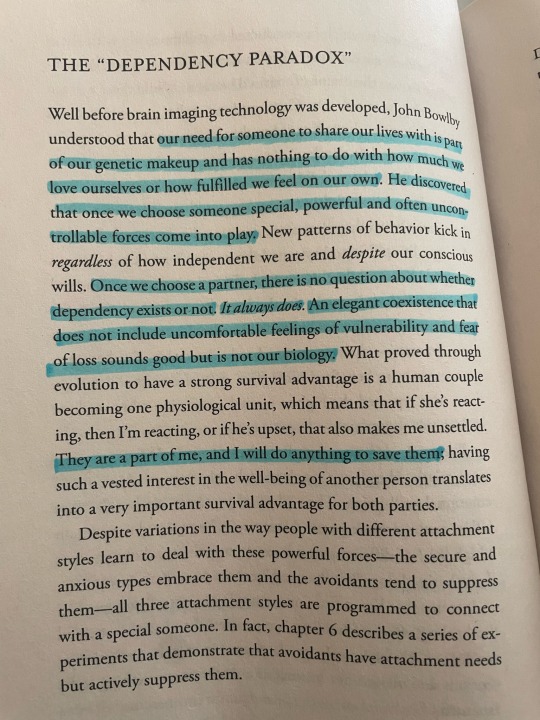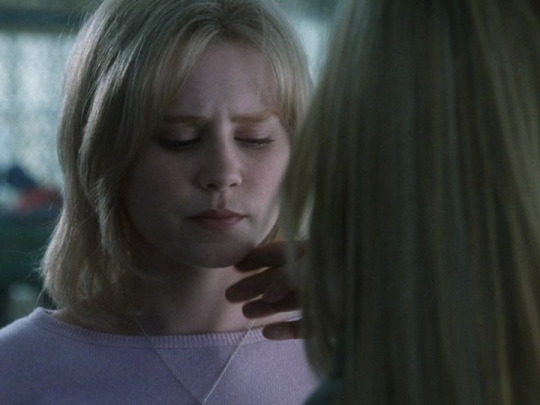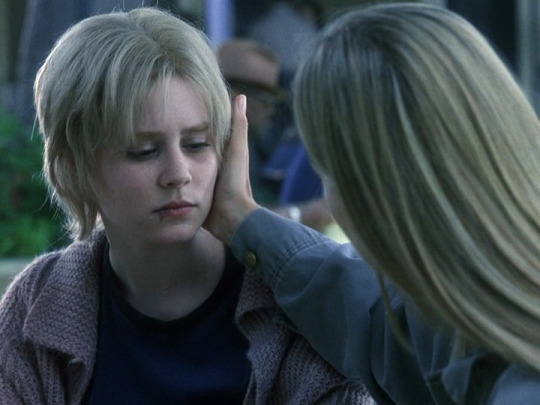#Disorganized attachment
Explore tagged Tumblr posts
Text
Anxious attachment styles are typically anxious to receive the love that they never received in childhood (even if it’s in unhealthy ways)
Avoidant attachment styles are typically afraid of love because love normally meant harm when they were a child (so they push away people they probably shouldn’t)
And disorganized people are typically afraid of love but are also anxious to receive the love they never received in childhood (so they either look for it in unhealthy ways or relationships become complicated due to the fear)
#attachment styles#attachment theory#anxious attachment#avoidant attachment#disorganized attachment#relationships#anxious attachment style#avoidant attachment style#disorganized attachment style#I don’t know why I posted this now#just relflecting I guess
81 notes
·
View notes
Text
nooo babe, he's just my emotional support friend who also happens to be in love with me
#girlblogging#girlblogger#female hysteria#female manipulator#femcel#bpd#female rage#i hate my bf#disorganized attachment#girlhood#ihatemybf#girlcore#hell is a teenage girl#girl core#girl blogger#girl interrupted#girl blog aesthetic#girl rotting#girl blog#girl blogging#girl boss gaslight gatekeep#toxic relationship#boy best friend#relatable#female insanity#lana del rey#lana del ray aka lizzy grant#lana del ray aesthetic#man eater#maneater
68 notes
·
View notes
Text
A Study in Survival: Disorganized Attachment and the Bonds of Nesta Archeron
a @nestaarcheronweek submission
So if you follow any of my work you know that I love to yap about psychological principles. Today I want to talk about attachment, and the trauma that occurs when you don’t get the bond you need.
Attachment styles are having a moment right now in pop psychology. It only takes a quick scroll through Instagram or TikTok (WebMD for mental disorders) to find a post about “dealing with an avoidant” or “heal your anxious attachment” or “10 things securely attached people do”.
I wanted to use today, Bonds day, to highlight a lesser-known pattern: disorganized attachment. We’re going to use Nesta Archeron as our case study.
But before we begin, a disclaimer: Nesta is a fictional character, so whether she does or doesn’t have disorganized attachment doesn’t matter. My credentials include a license in counseling and personal experience of disorganized attachment. These are my clinical interpretations of behavior based on the text. It’s not intended to be prescriptive nor diagnostic for any real people. If you identify with Nesta’s story or anything I detail here, help is available.
cw: non-graphic discussion of childhood trauma and abuse

We all know Nesta struggles when it comes to closeness. When we first meet her in ACOTAR, Nesta is angry at everyone but Elain. She hates their father, is disdainful of Feyre, and approaches relationships with utilitarianism. Tomas is attracted to me? Great, marry him for security.
Attachment is a blanket term that describes the phenomenon of infants bonding with their caregivers. Bonding is essential in the first few years of life, especially the first few months. Infants who are held, attended to when they cry, and have their basic needs met develop a fundamental trust in the world around them. They learn on a pre-thought level that they can expect others to to care about what’s happening to them, and when they don’t, that’s the exception. This is called secure attachment.
There are a lot of competing theories about why and how the other attachment patterns form. The evolutionary theory from Dr. John Bowlby suggests that bonding between children and caregivers was essential to survival. Humans generally have one baby at a time, and a baby left alone in the outdoors isn’t going to last for long. Through instinctive behaviors that invoke a drive to attend in others (crying, screaming, smiling, clinging), infants can ensure that their needs are met. Through consistent and repeated response to needs, this bond and the trust associated with it solidify, so in the event a caregiver cannot attend to the child, it is a temporary rupture that can be repaired instead of the basis for viewing all relationships.
Think about it in terms of ancient humans: when threatened by the outside world, does the child have a safe place to go back to? Is there a fire to gather around where they can expect to be fed and comforted and kept warm? What if it’s only there sometimes, but they can’t predict when? Or is all the world a dark night full of predators?
And beyond this, what if the attachment figure is the predator? Someone with disorganized attachment patterns may experience the caregiver as the direct source of harm via abuse.
From what we know in canon, Nesta’s childhood was not so warm and fuzzy. The facts we have are that before age ten her grandmother was physically abusive, her family assumed from birth that she would marry nobility (and trained her accordingly), her mother was verbally and emotionally abusive, and her father did not step in effectively to stop this. No one was meeting her emotional needs effectively. Add to this that nearly 80% of children who experience abuse display some degree of disorganized attachment, and it seems pretty obvious.
So if we imagine her partaking in Mary Ainsworth’s Strange Situation Procedure, what would we expect to see? Distress when her mother leaves, fear when she returns, and ambivalence about whether or not to go to her for comfort. A child who has not learned a mostly-effective strategy for soliciting care because the attachment figure is too unpredictable, and the price of being wrong is too high (abuse).
This can affect a person into adulthood in a number of ways, regarding both self-concept and relationships with others.
I want you to imagine that almost every time you made eye contact with a person you love, they never smiled. It’s natural that you would begin to wonder if you’ve done something wrong. You try different things, but they still never smile. Even if they smiled once, repeating the same action doesn’t cause it to happen again. So it’s not what you’re doing that’s wrong—you are wrong. Something about you is not worth smiling at, no matter what you do. Maybe you’re just a person who doesn’t deserve to be smiled at. You’re not good enough. And when you have no other relationships to fall back on, no independently-built self-concept to contradict that, you develop a core identity of shame.
Children do not have the ability to label their caregiver as the one doing wrong when they are very young. Believing so would mean that NO one is looking out for them, they are alone, and thus will not survive. Abandonment to children feels like death, because at one time that's what it meant. Instead the child splits and places all good characteristics onto the parents, and all bad ones onto themselves, in order to get enough security to keep living.
Nesta grew up in a loveless house, describing no warmth from either parent. She was constantly being criticized and allowed to be hurt by her grandmother. It would be a rare child that doesn’t grow up in that situation thinking something is wrong with them.
But we don’t even have to know the details to see these threads in the present. Nesta is wary of ALL relationship. She does not trust others have her best interest at heart. She does not believe other people will inherently like her. She feels deep shame about her own emotions (regardless of the behaviors) and punishes herself for coming up short. She self-medicates with substances—VERY common—and we never see her demonstrate healthy self-esteem. These are all hallmarks of a person who did not have the opportunity to experience loving, secure attachment in childhood.
(Sidebar: this is how we do trauma therapy with incomplete/inaccessible memories or when people don’t want to go into detail. We focus instead on what exists now in the debris field of the trauma.)
Okay, now that we’ve established the core shame identity, let’s talk about relational trauma. According to Pete Walker, a licensed marriage and family therapist who studies and has written several books on complex post-traumatic stress, asserts that the conditions that create disorganized attachment are inherently traumatizing. The core wound of all abuse is emotional neglect, which is the failure of the attachment figure to attune to and meet the needs of a child.
One of the most insidious ways C-PTSD manifests is via emotional flashbacks. These are so ingrained the person doesn’t know they’re happening unless they build conscious awareness of them. Emotional flashbacks are moments when past feelings visit the present via remembered sensations of relational trauma.
A person gets cut off in traffic and experiences the feeling of their dad raging until he gets his way. Someone gets an email notification from their boss and feels a rush of fear that they’re in trouble, traveling back to a time they might not even consciously remember, when their mom didn’t speak to them for a day because they used the wrong soap.
Emotional flashbacks can be extremely subtle. The other day I realized I was feeling shame because I “can’t do pillows right”. I’ve been having pain in my neck and struggling to find the right configuration that helps me sleep better. And I legitimately caught myself feeling self-hatred because wow I’m so dumb that I can’t figure that out I'm such a worthless person. As if it’s even possible! to be bad! at PILLOWS!
I believe we see Nesta having emotional flashbacks throughout the series. The IC showing up to her door demanding help—great, here’s person who wants something from me I don’t want to give, this will end in pain. Her difficulty moving on from the events of the war—what’s wrong with me, why can everyone else just move on? Cassian loving her—love always comes at a price I have to pay because I’m not inherently worthy. She repeatedly mentions not feeling deserving of him. So she employs strategies learned over time in order to protect herself.
People with disorganized attachment patterns suffer in relationships, and they suffer out of them. They want connection desperately but are terrified when they receive it. They employ mechanisms to defend their frightened inner child that habituate over time. It’s not uncommon for people with C-PTSD to develop a default stress response (fight/flight/freeze/fawn) instead of having access to the utility of the whole spectrum.
It might sound funny, but I believe Nesta is a habituated freeze type. As an adult she has more of an ability to fight back, which she does employ, being sharp and cold as a way to prevent people from getting close or trying to take advantage of her. But fight types tend to blame others for their feelings. Yet over and over again we see Nesta blame herself. And in moments of greatest stress, we see her collapse. Her alcohol use. The hike. Her submission to Rhysand after giving Bryce the Mask. Even all of the books to a certain extent. I think about how she must’ve survived with her mother and grandmother—learning how to take it, how to swallow her feelings and perform.
Stress responses exists in a hierarchy, and habituated freeze types are often called the most profoundly abandoned children, as they were not able to employ fight, flight, nor fawn in response to danger. They instead utilize a kind of deadened endurance to survive harm by escaping within. If you’re even seen a prey animal go limp while being attacked, this is the freeze response taken to its extreme conclusion, where the animal is flooded with natural opiates as they prepare to die.
Healing disorganized attachment is not simple or easy. I don’t say that to be a downer, but because relearning trust is really complicated. It takes very deliberate awareness of unconscious patterns, tireless repetition of redirections away from those patterns, and acceptance that the past is affecting us in the present whether we want it to or not.
Learning to ask for help and comfort, to even acknowledge you want it, is so fucking hard. There are days for me it legitimately feels like dying, to ask.
But it is possible via neuroplasticity, the brain’s ability to form new pathways. By doing the daily work, surrounding ourselves with safe people for “reparenting by committee”, and commitment to a vision of ourselves as a worthy person, we can start to rewrite the story of our own self-concept.
I hope to see this for Nesta in the future. We see her begin to explore this is her relationships with Gwyn and Emerie, and to a certain extent Cassian. I think she has the hope for it, and some of the right people, and the willingness to keep trying even when it’s painful and dark. If I were her counselor, I would encourage her to look at the places where she gives others grace that she does not give herself, and to be curious about why. What actually is the value you want to uphold? Is it kindness? Then why are you the exception? And is that reason actually true?
Okay that’s it. Hope this was coherent. Happy Nesta Week!
#nestaweek2025#nesta#nesta archeron#nesta archeron deserves better#disorganized attachment#attachment styles#c ptsd#prythian university
32 notes
·
View notes
Text
Telling you that I need affection and reassurance feels like a death sentence
#bpd vent#bpd problems#bpd relationships#bpd thoughts#actually bpd#bpd#actually mentally ill#anxious attachment#avoidant attachment#disorganized attachment
2K notes
·
View notes
Text
Are you CODEPENDENT?! Turns out biology says thats fucking normal

#mental health#actually neurodiverse#disorganized attachment#avoidant attachment#bipolor#black girls of tumblr
11 notes
·
View notes
Text
Shout out to people with Complex Dissociative Disorders (parents edition):
If your parents genuinely changed and improved overtime
If your parents were absent when you were a kid because they were sick / ill / working / otherwise indisposed
If your parents were not your abusers
If your parents would have acted differently if they knew you were being abused
If your parents didn't have the resources or knowledge to help / understand you
If your parents were loving and yet still neglectful
If your parents inadvertently invalidated / didn't believe you, but now do
If your parents weren't your primary caregivers when the abuse happend
If you weren't abused at all and your trauma was medical / environmental / etc
Had emotionally and physically present parents but you still had disorganized attachment with them as a kid because of your delusions / paranoia / etc.
If your parents regret how they treated you
If your parents loved and love you but acted the way they did because of substances / mental illness
If your parents are not completely bad people, or bad people at all
If you still get along with your parents regardless of what they did
If you ever invalidated your own traumatic childhood experiences because your parents were "too nice"
Your trauma is not less valid if you get along with your parents today. Sure, you needed disorganized attachment to your primary caregivers as a kid to develop a CDD. But that can take plenty of formes, and they don't all include your parents being monsters.
Edit: any other emotions regarding your parents are also valid and okay, and I couldn't mean that more. Childhood trauma survivors go through so many rough emotions, and self-invalidation is sadly way too common. Your feelings are a direct result of what happened and that makes them normal.
#i didn't see this be talked about much so take this shoutout list#disorganized attachment#actually did#did community#did system#dissociative identity disorder#traumagenic did#actual did#actually dissociative#did osdd#osddid#osdd#osdd system#actually osdd#pdid#pdid system#partial did#ddnos
3K notes
·
View notes
Text
there are two wolves inside me (i have disorganized attachment)
126 notes
·
View notes
Text
whenever I ruin people's perception of me by telling them I have an avoidant attachment style 😃😊
#sometimes I feel like people just project who they think I am on me#especially men#also avoidants are a bit misunderstood#avoidant attachment style#avoidant attachment#avoidance#disorganized attachment#fearful avoidant
56 notes
·
View notes
Text
they need to invent a me who doesn’t have severe attachment and abandonment issues
#ik i’m being irrational but i feel like my fp is gonna leave me and i’m just. running in circles#i’m being immature and stupid and jealous i know#personal#bpd#actually bpd#actually borderline#borderline personality disorder#cluster b#disorganized attachment#cluster b safe#bpd fp#favourite person
264 notes
·
View notes
Text


"you still belong to me"
#mother daughter issues#mother daughter relationship#white oleander#mother!#narcissistic mother#narc mom#astrid magnussen#ingrid magnussen#alison lohman#michelle pfeiffer#girl interrupted#girl problems#pale grunge#thirteen movie#thirteen 2003#thirteen#disorganized attachment#lizzy grant#lana del rey#female experience#my post
58 notes
·
View notes
Text
I'm so tired of hurting myself and everyone else in the act of trying to avoid hurting myself and everyone else.
#bpd#actually bpd#cluster b#npd#actually npd#mine#borderline personality disorder#actually borderline#bpd problems#fuck bpd#avoidant#disorganized attachment#fearful avoidant#🙃
546 notes
·
View notes
Text
only time I miss a man is when I swing and he ducks
#girlblogging#girlblogger#female hysteria#female manipulator#femcel#bpd#female rage#i hate my bf#disorganized attachment#girlhood#girl blog#hell is a teenage girl#Ihatemybf#borderline personality disorder#girl core#girl blogging#girl blogger#girl interrupted#misandry#i hate men#i am just a girl#girl blog aesthetic#girl rotting#girl interupted syndrome#lana del rey#lana del ray aesthetic#lana del ray aka lizzy grant#girl rage#female insanity#girl boss gaslight gatekeep
226 notes
·
View notes
Text
I'm so replaceable
#bpd vent#bpd problems#bpd relationships#bpd thoughts#actually bpd#bpd#actually mentally ill#anxious attachment#avoidant attachment#disorganized attachment
2K notes
·
View notes
Text
I hide the part of me that needs to be loved the most and then crave to be loved as a whole.
#tw depressing stuff#actually mentally ill#emotional neglect#vent#tw vent#avoidant attachment#actually traumatized#disorganized attachment
739 notes
·
View notes
Text
1) Love can’t be earned
2) Differentiate between fear and love
3) Know when you’re walking away from the things you desire most
20 notes
·
View notes
